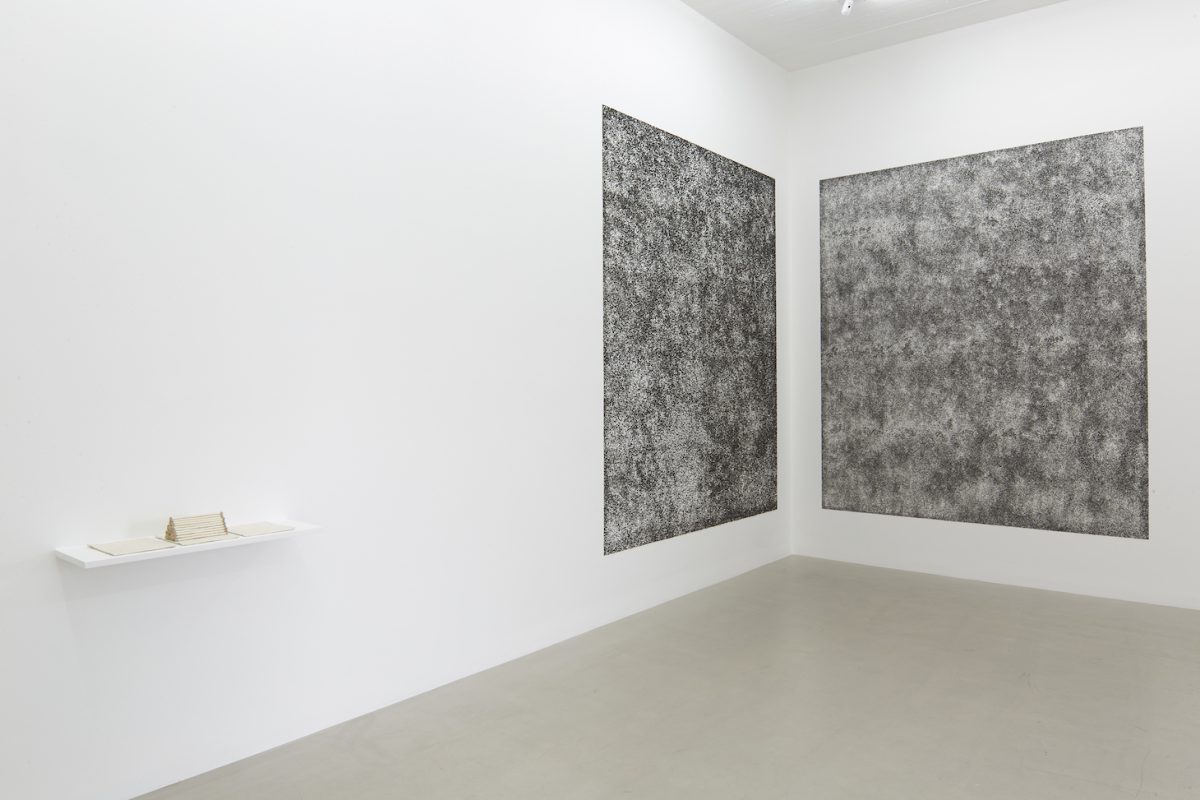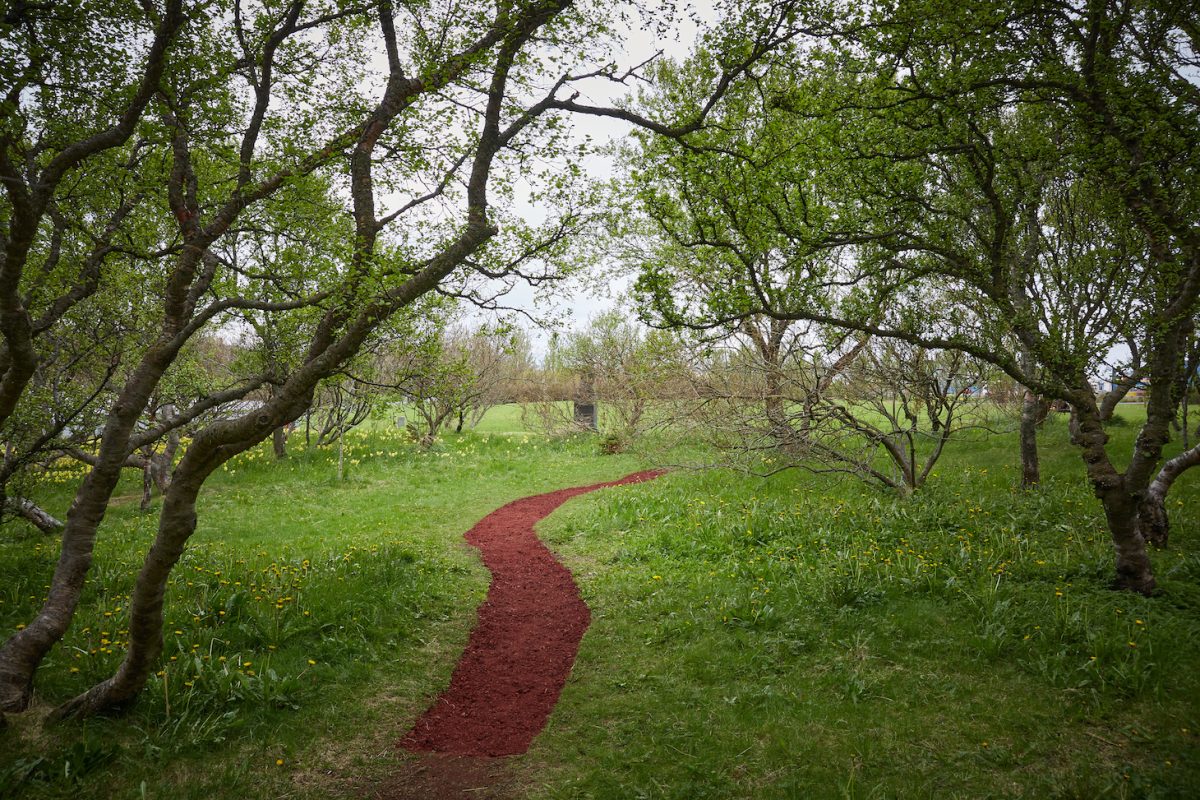
REYKJAVIK — The Fagradalsfjall volcano is currently erupting quite close to Iceland’s capital city, Reykjavik, drawing throngs of rapt visitors. With ever-shifting displays of primal power, including molten fireworks and spectacular lava flows, this is the first eruption on the Reykjanes peninsula in some 800 years, although abundant lava formations and moss-covered lava fields attest that volcanic activity has been commonplace in this area for millennia. Many volcanologists think that the eruption may well last for years.
This is an extraordinarily apt backdrop for Icelander Ragna Róbertsdóttir’s exhibition at Reykjavik’s i8 Gallery. Three of her elemental artworks (two in the gallery, one in a nearby park) are made from actual lava, long one of her chief art materials; she fashions sculptures and wall works from the primary substance of her volcanic and volatile homeland.
Róbertsdóttir’s wall works — she has made many through the years, in different sizes and architectural settings — are called “lava landscapes.” An excellent new one is in this show, with two identically sized (118 1/8 by 98 3/8 inches) parts on an adjacent wall (“Lava Landscape,” 2021). They seem at first to be mirror images, but are anything but. From a distance, they resemble abstract, black on white paintings — variations on monochromes, perhaps, full of swirling and billowing activity.

Move up closer to be astonished. No paint is involved, and no canvas. Instead, thousands of black lava pebbles affixed to the walls yield bristling, fluctuating, three-dimensional surfaces. The lava is from the famous volcano Hekla. Róbertsdóttir’s lava-gathering experiences in the awe-inspiring highlands — akin to what Robert Smithson once called “primary envelopment” — underpin these works.
Róbertsdóttir’s compositional process is novel. She prepares a painting-like section of the wall with glue, then rapidly flicks handfuls of lava at it, much of which sticks, while some falls to the floor. Control is involved, but so too is chance, along with humidity and temperature. (While related, each of Róbertsdóttir’s “lava landscapes” differs, sometimes markedly so.) She makes her own personal, humble, indoor eruptions, channeling the vast geological forces operative in Iceland into artworks.
After the glued section of wall is largely covered, Róbertsdóttir adds more pebbles, sometimes even single ones using tweezers, teasing out the complex structure that she wants. Her new work is enthralling. The left part is made of coarse lava, and the right of fine lava; the interplay between parts is both subtle and dynamic. While static, this work seems exceptionally protean. From up close it engulfs one, an abstraction of forceful plumes jetting lava and ash into the sky. It also evokes expansive lava fields that stretch in all directions. It is remarkable that mere pebbles on white walls could be this engrossing and transportive.

“View” (2021) features red lava pebbles behind three double glass windowpanes leaning against the wall. The lava is from Seyðishólar in South Iceland. Róbertsdóttir fashioned it into swelling and sloping shapes that loosely resemble mountain contours; some shapes are partially occluded, as if we are looking at them through mist. It is utterly lovely, an indoor version of outdoor immensity, and it is made of nothing more than pebbles and glass.
The preeminent 20th-century Icelandic artist is Jóhannes S. Kjarval, who lavished attention on the structures and intricacies of lava in his landscape paintings. (For several reasons, including a harsh climate and crushing poverty during Danish colonial rule, Icelandic visual art pretty much began in the early 20th century.) Róbertsdóttir is altogether different. She is not a painter. She doesn’t make landscapes but instead abstract works that conjure powerful forces and immersive experiences in nature. She doesn’t depict lava but actually utilizes it. (Also, in various other works through the years, she has used seashells, red mud, ocean salt, obsidian, rocks, and crushed glass.) A profound engagement with things, with substances, and really with the vital, non-human world is fundamental to her art.
Róbertsdóttir’s uncluttered, beautifully installed exhibition includes new works, as well as relatively recent ones, and three older sculptures, making it something of a mini retrospective (the oldest is from 1981, at the beginning of her career, when she was very involved with textiles).

Five sizable brown turf rolls nestle in a row just in front of one wall (“Untitled,” 1991). This hefty sculpture seems surprisingly delicate, almost like a three-dimensional drawing, and the turf is compelling, with its subtle colors, varied materiality, and bits of dried grass haphazardly poking out.
Róbertsdóttir excels at ushering nature in many guises into artworks, and at giving eminently practical (especially in Icelandic terms) materials fresh contexts and possibilities. Turf is the essential material of Icelandic farms and has been for 1,100 or so years. It has also been an important building material for houses over several centuries. In this rhythmic, geometric configuration it has innate power and is especially enticing.

With “Untitled” (1987), a wide swath of tawny manila rope bound by linen threads stretches across the floor; two large, upright coils are at both ends. Two pieces of slate rest atop the middle part, on the floor. Róbertsdóttir has diverted manila rope, used routinely on fishing boats, ships, and farms, and the roof slate into a forthright yet quietly marvelous sculpture with both circular and planar forms, vertical and horizontal ones, understated yet still potent colors, and multiple textures.
Outsiders have often pegged Róbertsdóttir as an Icelandic minimalist influenced by Donald Judd, Carl Andre, Robert Morris, and others. This would be a mistake (and, in my ardent opinion, also a misguided one, situating the female Icelander Róbertsdóttir in relation to male Americans).
For one thing, when she was an emerging artist in the tiny Reykjavik art scene of the late 1970s and early 1980s, there was little information about, and even less direct experience of, minimalism as practiced in the United States and Europe.
For another, while minimalism in the US arose, in part, as a reaction to action-packed Abstract Expressionism, it has permeated Iceland throughout its history — in the muted colors of land, sky, and sea; stark lava formations and rippling lava fields full of small mounds; unpretentious houses and austere farms; white glaciers and thick fog; a culture-wide antipathy to ostentation and affinity for understatement; and even the matte, monochromatic colors of houses in Reykjavik’s old city, up north in Akureyri, and in many coastal villages. This is the minimalism with which Róbertsdóttir is most engaged, and while her work is not about Iceland, or Icelandic identity, a sensitive involvement with her very particular, and very special, natural and cultural environment is at the core of her art.

Iceland is Europe’s oldest democracy — the Althing, or national parliament, first convened in c. 930 CE — and also its youngest landmass, forming less than 33 million years ago. (By comparison, what is now New York City formed approximately 450 million years ago.) While the country is geologically young, the vast scale of time is palpable and pronounced. Whole areas are shaped by whopping eruptions, often from many centuries ago. Towering waterfalls course from glaciers that long predate human settlement. Because of Iceland’s famous medieval literature, the Sagas, many of which are rooted in historical fact, most Icelanders, in some measure, are familiar with the names and exploits of 9th- and 10th-century Norse settlers. The remote past is present in Iceland.
Róbertsdóttir’s “timescapes,” five of which are included in this show, are sterling silver or bronze panels in modest (and sometimes really small) sizes. Left untreated and exposed, their surfaces oxidize, tarnish, and radically change over time, particularly in Iceland, because of sulfur and moisture from underground geothermal water. Originally uniform silver, the minuscule (2 3/8 by 1 5/8 inches) “Timescape” (2013) now displays elaborate dark splotches and several colors. It resembles both an abstract painting or drawing and a landmass seen from a satellite’s height. The brand new “Timescape” (2021) is silvery and reflective; years from now will look very different. These works are made by the artist, but also by time and the elements.
While Ragna Róbertsdóttir does not make a point of addressing issues in her art, her thoughtful, understated work is especially relevant right now, given not just the erupting volcano but also the twin crises of the COVID-19 pandemic and global warming, the latter of which is causing Iceland’s glaciers to inexorably melt. Both crises upend (or should) the anthropocentric, wacky, dangerous, and increasingly lethal fantasy that we, as humans, are not just part of the living and changing planet, but are instead its lords and masters.

Róbertsdóttir’s approach is decidedly otherwise. She works with her materials and is in dialogue with them, always allowing for, and respectful of, their own power and agency. Non-human things matter to her, as well as where they are from, be they seashells from the Westfjords (“Seascape,” 2012, a chunk of concrete encrusted with seashells, is in this show), simple turf, or Hekla lava. She studies these things, learns from them, opens herself to them. One surmises that she cherishes them as well.
In a park close to the gallery, there is a winding dirt footpath. Suddenly, the footpath becomes rich crimson; Róbertsdóttir covered this part with red lava pebbles (“Path,” 2021). Humorously suggesting some glamorous red-carpet event, this welcoming work deftly connects wild nature and city, volcanoes and people. It is also a total joy to discover and behold.
Ragna Róbertsdóttir continues at i8 Gallery (Tryggvagata 16, 101 Reykjavik, Iceland) through July 31.
0 Commentaires